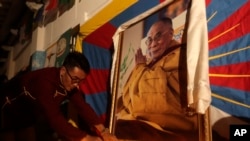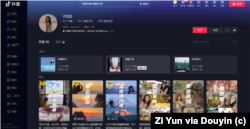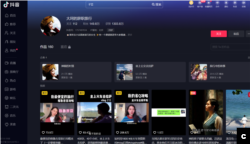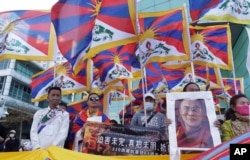On May 20, China’s state-run China Global Television Network (CGTN) promoted Tibet-related content from Zi Yun and Da Ke, “travel vloggers” on a platform called Douyin, China's version of TikTok.
Zi Yun has amassed over two million followers on the platform, and Da Ke has just under 1.5 million.
Thematically, the vloggers’ accounts as reported to CGTN mirrored Beijing’s talking points — mainly, that Tibet has developed greatly since China forcibly annexed it in 1951, and that there are no human rights violations in the region.
In her Douyin profile, Da Ke describes herself as a 28-year-old who quit her job to start documenting her travels.
She says she likes to go to "unique, less known places."
Speaking with CGTN, she relayed an exchange she claims to have had five years prior with an American tourist, who asked her if the Tibetan people were “oppressed.”
Da Ke said she probably responded in the wrong way at the time but had this to say now:
“There is no oppression at all. You have to visit this place if you want to find out the truth.”
That is false.
China’s attempts to force Tibetans to assimilate into Chinese society at the expense of their own language and culture — known as Sinicization — have long been punctuated by religious repression and other systematic human rights violations.
The International Tibet Network, a global coalition of Tibet-related nongovernmental organizations, described Tibet as “China’s laboratory for repression" and a place where "systems of mass surveillance and abject control” are honed.
Beijing’s efforts at cultural and religious suppression in the Tibet Autonomous Region, as in the northwestern Xinjiang Uyghur Autonomous Region, are regularly couched as being part of poverty alleviation schemes, which themselves have been marked by allegations of forced labor.
Last month, United Nations experts said Tibetans may not have consented to participate in “labor transfer” and “vocational training” programs.
The U.N. had earlier determined it was “reasonable to conclude” that Uyghurs and other ethnic minorities in Xinjiang are being subjected to forced labor under such programs.
The U.N. experts noted that Tibetans had been discouraged from using their own language and expressing their religious faith, “both considered obstacles to poverty alleviation by the authorities.”
The rights group Freedom House reported that hundreds of thousands of Tibetans continue to undergo military-led “vocational training,” under which they are forcibly subjected to “political indoctrination and forced separation from their communities.”
Religious repression is a key component of oppression in Tibet, as many Tibetans remain loyal to the Dalai Lama, Tibet’s highest spiritual leader who was formerly its head of government and head of state. The Dalai Lama was forced into exile in 1959.
One Tibetan shopkeeper served five years in prison for carrying a flag with a picture of the Dalai Lama on it.
Polygraph.info has catalogued other related abuses here.
Beijing has instituted a massive surveillance apparatus to control Tibetan religious life, particularly at monasteries and other religious centers.
Many aspects of Tibet’s modern surveillance state followed violent 2008 protests, themselves a reaction to China’s repression of Tibetan culture and religion.
China blamed the Dalai Lama for that violence.
In 2011, China’s “Benefit the Masses” surveillance campaign, which saw 21,000 Chinese Communist Party cadres dispatched in teams of four or more to each of Tibet’s roughly 5,000 villages, was initiated to prevent further protests like those in 2008, Human Rights Watch said.
Authorities imposed a grid management surveillance system intended, according to Chinese state media, to manage society "without gaps, without blind spots, without blanks,” Reuters reported.
This system of control features a beefed-up police presence, the expansion of security centers, pervasive CCTV surveillance and checkpoints that monitor movements in and out of cities, particularly Tibet’s capital, Lhasa.
Researchers note that government intervention extends to most aspects of Tibetan life.
That includes a mass collection of DNA in Tibet, which is apparently being conducted without “informed consent,” Human Rights Watch reported in September 2022.
Monks, political activists, independence advocates and those documenting unrest in the region have been imprisoned and tortured, resulting in some deaths.
In a 2022 report, the U.S. State Department said ““[i]mpunity for violations of human rights was pervasive,” with no reports of investigations or punishment of officials involved in “unlawful killings” and other abuses.
As in Xinjiang, the Chinese state leans on so-called social media influencers to whitewash allegations of grave human rights abuses and promote Beijing’s propaganda narratives.
While Zi Yun and Da Ke’s affiliation with Chinese state media is unclear, Chinese state-affiliated reporters have regularly posed as independent travel bloggers and influencers to boost government talking points.
The Associated Press, citing research from the cyber threat analysis and research company Miburo, reported in March 2022 that at least 200 influencers with connections to the Chinese state were using popular social media platforms to amplify government talking points in dozens of languages.
Ironically, some of those platforms, like Instagram, Facebook and YouTube, are blocked in China.
Miburo founder Clint Watts told the AP Beijing had settled on using female Chinese influencers to spread their message.
Prominent examples include Li Jingjing, a CGTN reporter who regularly spreads disinformation about Xinjiang, along with anti-U.S. propaganda mirroring Beijing’s foreign policy interests, on her “personal channel.”
The New York Times reported in December 2021 that “influencers” had been consistently promoted by Chinese diplomats and representatives, particularly on social media, where, according to the newspaper, “six of the most popular of these influencers” had by that time garnered more than 130 million views on YouTube and more than 1.1 million subscribers.








